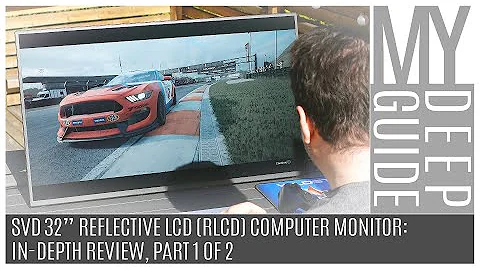What are the Best LCD Screen settings for reading PDFs
Solution 1
A 24'' monitor is indeed a little too big for a long eye exposure to text. Some people can take it without a problem. But these are usually young eyes. More tired eyes (or older) will have trouble with such monitors when doing concentration reading.
Here's a few loose ideas (meaning some may not couple well with others):
- Reduce empty space (which does fatigue the eyes) by setting at least a two-page view in your screen and increasing the pages zoom factor to occupy the most of your screen (without forcing you to scroll if that bothers you).
- Invert contrast if available (it seems you have it). But careful, only if you take more than one minute reading sessions. If you are constantly flipping between a dark screen and a white screen (like flipping between your PDF and your browser) this is in fact bad for your eyes.
- Set your PDF Reader to Read mode (or Full Screen if unavailable). On most readers, this turns the background black and the white page in the center with a reasonable zoom factor that you may have or not the ability to change. Many people find this the least tiring method.
- Get yourself a vertical monitor (or a rotatable one) between 19'' and 21''. These screen sizes are the least damaging to your eyes, force less eye movement and are very friendly to a wider range of space between you and the monitor (a larger monitor forces you to place it further away). Vertical if you can, because you will be able to use higher zoom factors without forcing you to scroll within the same page.
Solution 2
Adding to others advice: Another way to smoothen the reading session is f.lux when you're reading in the evening. It makes the screen's color display adapts to the time of day, automatically. Available for free for all major OS'es.
Solution 3
Some tips:
Sit at a comfortable distance from the screen. If you're too close then you'll be turning your head and/or eyes a lot.
Change the zoom level so that the words are a comfortable size for your eyes.
The brightness of the areas around your monitor should be the same as the average brightness on your monitor. All human eyes automatically do something called saccades where they flit around every once in a while to get extra contextual information for the brain. If, for example, you are in a dark room with a bright monitor, your iris will have to keep changing between more-closed (when looking at the monitor) and more-open (when flitting to the dark non-monitor background). This can cause fatigue, headaches, etc.
Depending on your eyes, the monitor, and your distance from the screen, you might consider the heretical choice of running the reader on Windows instead of OS X. Hear me out. Apple has the philosophy that all text should be positioned exactly as if it were printed, even if that means that it creates fuzziness when antialiased on a screen. Microsoft's philosophy is that a document should look good if viewed on a monitor and it's okay to shift font strokes by sub-pixel amounts to avoid blurriness. If you're a professional doing layout for a print process, the Mac is probably the better option. If you're just trying to read some text with little eye strain, there are those that would argue Microsoft got it right. It's possible that Adobe has some option on the Mac version to use Microsoft's rendering choices, avoiding the need to install a VM or bootcamp.
Solution 4
Regarding brightness: I once read that white areas on your monitor should match the brightness of a white sheet of paper when you hold it next to your screen. This way reading from the screen should be about as easy to the eyes as reading from paper and your eyes don't have to switch between monitor-brightness and room-brightness.
I've tried it and it works for me.
At the beginning it seems to be very dark and of course you have less contrast, which makes the content of the screen not look as nice. But you'll adjust to that quite quickly (I'd say it takes a day at max).
Of course, this assumes that your room lighting is constant.
Related videos on Youtube
Brock Woolf
I am a software developer and university student based in Perth, Australia. I work on my own software projects in my spare time and write applications and games for iPhone and Mac OS X. You can see some of the software I've written here, or you can find out more about me and how to get in touch here.
Updated on September 17, 2022Comments
-
Brock Woolf almost 2 years
Hi I need to read PDF files but find that my 24" LCD screen fatigues my eyes too much. I realise that eInk screens are better but I do not currently possess one and so have to use LCD's.
Can you tell me what are the best settings for reading PDF's on an LCD in terms of:
- PDF display % size
- PDF reader application
- Screen size
- Screen brightness
Screen contrast
Anything else you have found helps
I am currently running a 17" Macbook Pro with an external 24" BenQ LCD
-
A Dwarf over 14 yearsYour third point is interesting. But raised me one doubt. Assuming the PDF document isn't a scan (in which case it would be irrelevant), doesn't Mac offer an equally attractive and "highly" configurable equivalent of the Windows ClearType? I think remembering this was a problem a couple of years ago (they were blurrier indeed). But I seem to have been told it has improved since.
-
 Roberto Russo over 14 yearsfifth point: ... than print it and read on paper.
Roberto Russo over 14 yearsfifth point: ... than print it and read on paper. -
Brock Woolf over 14 yearsYes. Mac OS X does font anti-aliasing. The text looks the same in inverted colours mode (sorry, not inverted contrast) I just found it easier because the monitor was less bright. It's easier to stare at a black screen than a white one (It's late at night right now)
-
Mr Fooz over 14 years@A Dwarf: perhaps you're right. It's been a while since I've used a Mac (I tend to prefer Windows and Linux). I'll have to check with someone who is a current Mac user.
-
Mr Fooz over 14 years@Brock & A Dwarf: when it does font anti-aliasing, does it take liberties with stroke placement like Windows (reducing blurriness), or does it do strict stroke placement (keeping the spacing the same as the printed form)? Note that cleartype effectively triples the horizontal resolution for text; stroke placement is an independent matter (but is 3x less important with cleartype).
-
Mr Fooz over 14 years@Brock: If you have a dark room, then inverted text should be easier on the eyes. If you have your monitor's white level matching the surrounding light level, then black text on a white background should be better.
-
Brock Woolf over 14 yearsI took your point about font rendering. I use both Windows and Mac but i do not find one easier to read than the other. Thanks for the observation though.
-
Mr Fooz over 14 years@Brock: Since you have both, would you be so kind as to take a screenshot of the same PDF rendered at 100% on both Mac and Windows (with ClearType and all that stuff enabled), then post the screenshots somewhere? I'd be interested in seeing how different they are at the pixel level these days.
-
Brock Woolf over 14 yearsI did find the vertical monitor much easier for reading text, along with lowering my monitor brightness. Thanks and thank you for everyone else's answer, they all helped.




